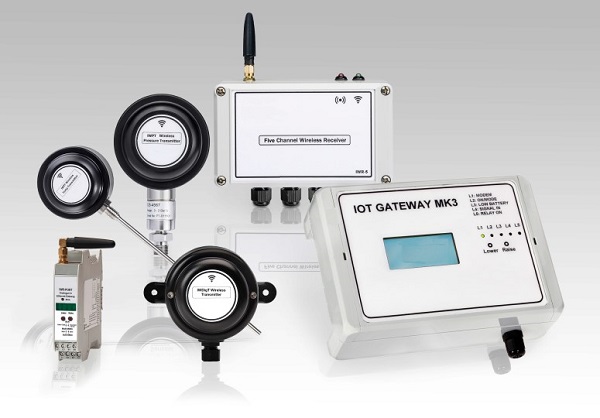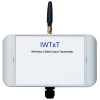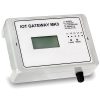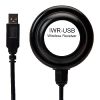
A complete wireless sensor and receiver system for use in industrial applications to communicate with a suite of battery powered measurement devices and send readings via analog signals, USB, RS232, RS485, Ethernet or mobile phone network.
Product Features
- Battery powered wireless sensors
- Measure temperature, pressure, humidity, tilt, potentiometer & analog signals
- Receivers to manage polling each wireless sensor
- Send channel data via analog signal, digital coms or mobile network
- Software for managing all system devices, configuration and setup
IWT Series Wireless Sensor Transmitters
 IWPT Wireless Battery Powered Pressure Sensor and Receiver - Wireless battery powered pressure sensor and receiver system for connecting pressure sensors without wires to a central wireless receiver which converts each received pressure signal channel to a 1-5Vdc, 4-20mA output, USB, Ethernet TCP, RS232 RTU, RS485 RTU or 2G 3G 4G mobile cellular network.
IWPT Wireless Battery Powered Pressure Sensor and Receiver - Wireless battery powered pressure sensor and receiver system for connecting pressure sensors without wires to a central wireless receiver which converts each received pressure signal channel to a 1-5Vdc, 4-20mA output, USB, Ethernet TCP, RS232 RTU, RS485 RTU or 2G 3G 4G mobile cellular network. IWmAT 4-20mA Signal Input to Wireless Transmitter - Measure the current loop signal output from any 4 to 20 milliamp transmitter, and wirelessly transmit it to a wireless receiver hub
IWmAT 4-20mA Signal Input to Wireless Transmitter - Measure the current loop signal output from any 4 to 20 milliamp transmitter, and wirelessly transmit it to a wireless receiver hub IWVT 0-10Vdc Signal Input to Wireless Transmitter - Measure the signal from any 0 to 10 volt output measurement device, and wirelessly transmit it to a wireless receiver hub
IWVT 0-10Vdc Signal Input to Wireless Transmitter - Measure the signal from any 0 to 10 volt output measurement device, and wirelessly transmit it to a wireless receiver hub IWTT Wireless Battery Powered Temperature Sensor - Temperature sensing probe for wirelessly transmitting temperature readings from 3 wire PT100 platinum resistance thermometer, J or K type thermocouples.
IWTT Wireless Battery Powered Temperature Sensor - Temperature sensing probe for wirelessly transmitting temperature readings from 3 wire PT100 platinum resistance thermometer, J or K type thermocouples. IWTaT Wireless Ambient Temperature Sensor - Measure ambient temperature from -40 to +80 degrees Celsius and transmit it wireless to a central wireless receiver
IWTaT Wireless Ambient Temperature Sensor - Measure ambient temperature from -40 to +80 degrees Celsius and transmit it wireless to a central wireless receiver IWTRhT Wireless Ambient Temperature and Relative Humidity Sensor - Measure ambient temperature (Tamb) from -40 to +80 degrees Celsius and relative humidity (RH) from 0 to 100%, and wirelessly transmit them both to a wireless receiver hub
IWTRhT Wireless Ambient Temperature and Relative Humidity Sensor - Measure ambient temperature (Tamb) from -40 to +80 degrees Celsius and relative humidity (RH) from 0 to 100%, and wirelessly transmit them both to a wireless receiver hub IWTxT Loop Powered 4-20mA Input to Wireless Transmitter - Power and measure the current loop signal output from any 4 to 20 milliamp transmitter, and wirelessly transmit it to a wireless receiver hub
IWTxT Loop Powered 4-20mA Input to Wireless Transmitter - Power and measure the current loop signal output from any 4 to 20 milliamp transmitter, and wirelessly transmit it to a wireless receiver hub IWDigT Switch or Pulse Input to Wireless Transmitter - Measure the open and closing of any voltage free contact switch or a pulses from a counter input, and wirelessly transmit it to a wireless receiver hub
IWDigT Switch or Pulse Input to Wireless Transmitter - Measure the open and closing of any voltage free contact switch or a pulses from a counter input, and wirelessly transmit it to a wireless receiver hub IWCTT Current Transformer mV ac Signal Input to Wireless Transmitter - Measure the millivolt alternating current output from any split core current transformer and wirelessly transmit it to a wireless receiver hub
IWCTT Current Transformer mV ac Signal Input to Wireless Transmitter - Measure the millivolt alternating current output from any split core current transformer and wirelessly transmit it to a wireless receiver hub
IWR Series Wireless Receivers
 IoT Gateway Wireless Sensors to 2G 3G 4G Modem Receiver - The IoT Gateway allows virtually any sensor to be monitored from anywhere with a Cellular connection.
IoT Gateway Wireless Sensors to 2G 3G 4G Modem Receiver - The IoT Gateway allows virtually any sensor to be monitored from anywhere with a Cellular connection. IWR-5 Five Channel Wireless Sensor to 4-20mA or 1-5Vdc Output Signal Receiver - The IWR-5 is a five channel receiver designed to pair with IW series of wireless sensors and provide a 4-20mA or 1-5Vdc output signal
IWR-5 Five Channel Wireless Sensor to 4-20mA or 1-5Vdc Output Signal Receiver - The IWR-5 is a five channel receiver designed to pair with IW series of wireless sensors and provide a 4-20mA or 1-5Vdc output signal IWR-USB Wireless Sensors to USB Gateway Receiver - The IWR-USB Gateway provides a link between wireless sensors and any PC with a USB connection
IWR-USB Wireless Sensors to USB Gateway Receiver - The IWR-USB Gateway provides a link between wireless sensors and any PC with a USB connection IWR-PORT Wireless Sensors to Ethernet, RS232 or RS485 Gateway Receiver - The IWR-PORT Ethernet Gateway provides a link between wireless sensors and sensor networks and Industrial Ethernet or RS-232/485 networks.
IWR-PORT Wireless Sensors to Ethernet, RS232 or RS485 Gateway Receiver - The IWR-PORT Ethernet Gateway provides a link between wireless sensors and sensor networks and Industrial Ethernet or RS-232/485 networks. IWR-1 Single Channel Wireless Sensor to 4-20mA or 1-5Vdc Output Signal Receiver - The IWR-1 is a single channel receiver designed to pair with IW series of wireless sensors and provide a 4-20mA or 1-5Vdc output signal
IWR-1 Single Channel Wireless Sensor to 4-20mA or 1-5Vdc Output Signal Receiver - The IWR-1 is a single channel receiver designed to pair with IW series of wireless sensors and provide a 4-20mA or 1-5Vdc output signal
Applications
Irrigation rig monitoring
Monitors the current taken by motors driving large scale irrigation rigs. Used to check for overloaded motors, sometimes due to flat tyres on the wheels fitted to them.
Railway embankment monitoring
Using buried MEMs inclinometers to monitor movement in embankments.
Monitoring of CNC machine fixtures
Using wireless transmitters embedded into fixtures to monitor hydraulic clamping pressure and alarm if changes are detected.
Solar farm high terminal monitoring
Uses digital temperature ICs to check for high resistance joints in solar farm DC combiner boxes and substations.
Motor condition monitoring
Monitoring of 500+ production motors for HRJs, phase imbalance and increased load conditions.
Log loader load weighing
Uses hydraulic pressure to weigh the quantity of logs loaded onto a low loader.
Rotating oven temperature measurement
Uses wireless thermocouple transmitters to replace inherently unreliable slip rings.
Vibration monitoring
Monitors raw vibration data from industrial accelerometers in iron ore and coal mines.
Waste treatment works sludge depth monitoring
Sends the sludge depth signal wirelessly to receiver to eliminate the requirement for slip rings
Sculpture tamper monitoring
System monitors sculptures for movement & vibration to send an SMS alarm if a sculpture is being attacked or stolen.
Piling rig concrete pressure monitoring
Monitors the pressure of the concrete at swan neck at the top of the piling rig to detect when the concrete is backing up
Car all-over water spray pressure monitoring
Monitoring of motor vehicle under-body and over-body spray water pressure.
Office temperature & RH monitoring
Monitors the temperature and relative humidity in commercial offices during HVAC installation acceptance period.
Building fire temperature monitoring
1-2m long wireless thermocouple transmitters used to monitor the internal temperature of buildings used during fire testing.
Wine fermenting temperature monitoring
Used to measure the temperature of fermenting wine inside winery vats.
Wellhead pressure monitoring system
Measure well head pressure levels.
Excavation monitoring
Monitors the level and force on struts supporting large scale excavations.
Quarry water usage
Transmits water meter pulses wirelessly across a quarry to a central location.
Grain silo temperature measurement
Long temperature probes inserted into grain silos to check for rises in temperature which may indicate that fermentation is commencing.
Cement mixer weight monitor
Wireless pressure sensors mounted to the hydraulic drive circuit on cement mixers. The hydraulic pressure was used to indicate how much force was needed to rotate the drum on the vehicle, this in turn indicated how full the mixer was. Used in central filling station.
Water reservoir signal transfer
The IWT-128 was used as a cable replacement system to transfer analogue and digital signals across water reservoirs.
pH signal transfer
Picked up the output from a pH meter and wirelessly transferred this to a central dosing control system.
Multiple borehole level management
Monitored water levels in multiple boreholes so that the central controller could decide which to pump water out of.
Overhead trolley wear monitoring
Monitors the force on motor drive stations using load cells embedded into trolley blocks. If the force reduces, the rack drive starts to slip and the line may stop.
Tailgate opening system
Automatically opens the tailgate on motor vehicles on the production line, when operators require access to the rear of the vehicles.
Grain silo level measurement
Bottom mounted level sensors wired to antennas at the top of each silo. Wireless network was effectively in the air above the silos which overcame the problem of getting a wireless signal around lots of metal silos in a small area.
Product Help
Battery-powered wireless RTD monitoring with Modbus integration
I need a battery-powered solution to monitor four RTD temperature sensors. It must transmit readings wirelessly up to 200 meters and integrate with an existing Modbus TCP/RTU gateway. What equipment would you suggest for this task?
We would suggest the 4 x IWTT-Node-PT wireless temperature transmitter and a IWR-PORT wireless receiver for this application. The IWTT-Node-PT supports PT100 probe inputs, and is designed for long term operation on battery power up to 5 years at 10 second transmission interval update rate. The wireless system is designed to covers distances exceeding 200 metres, and the IWR-PORT can be specified with a Modbus TCP/IP (Ethernet) or Modbus RTU (RS485) output ensuring compatibility with your existing system.
Wireless sensor protocol
What type of protocol does this wireless sensor system use?
All the IW series wireless transmitters and receivers use the Long Range IEEE 802.15.4. 2.4GHz standard protocol.
Using more than one receiver with the same transmitter
Can more than one type of receiver be setup to read from the same wireless transmitter without causing any conflict, or is it that not recommended?
Yes more than one receiver can be used to receive signals from the same transmitter.
It’s not quite as robust as a single receiver in that if one receiver acknowledges the signal but that signal hasn’t got to the other, the transmitter won’t try again until the next update period (typically 10s).
Related Documents
Wireless Sensor Transmitters Data Sheets
- IWPT pressure sensors
- IWTT temperature probes
- IWTaT ambient temperature
- IWTRhT ambient temperature & humidity
- IWTxT loop powered 4-20mA signal input
- IWmAT 4-20mA signal input
- IWVT 0-10Vdc signal input
- IWDigT switch/pulse count input
- IWCTT current transformer mV ac signal input
Wireless Receivers Data Sheets
- IWR-1 single channel 4-20mA / 1-5Vdc output
- IWR-5 five channel 4-20mA / 1-5Vdc output
- IWR-USB universal serial bus interface
- IoT Gateway mobile network
- IWR-PORT Ethernet, RS232 or RS485 data sheet
Request Product Price
Please select the options you require for the IW Series Industrial Wireless Measurement System in your application and request a quote.
